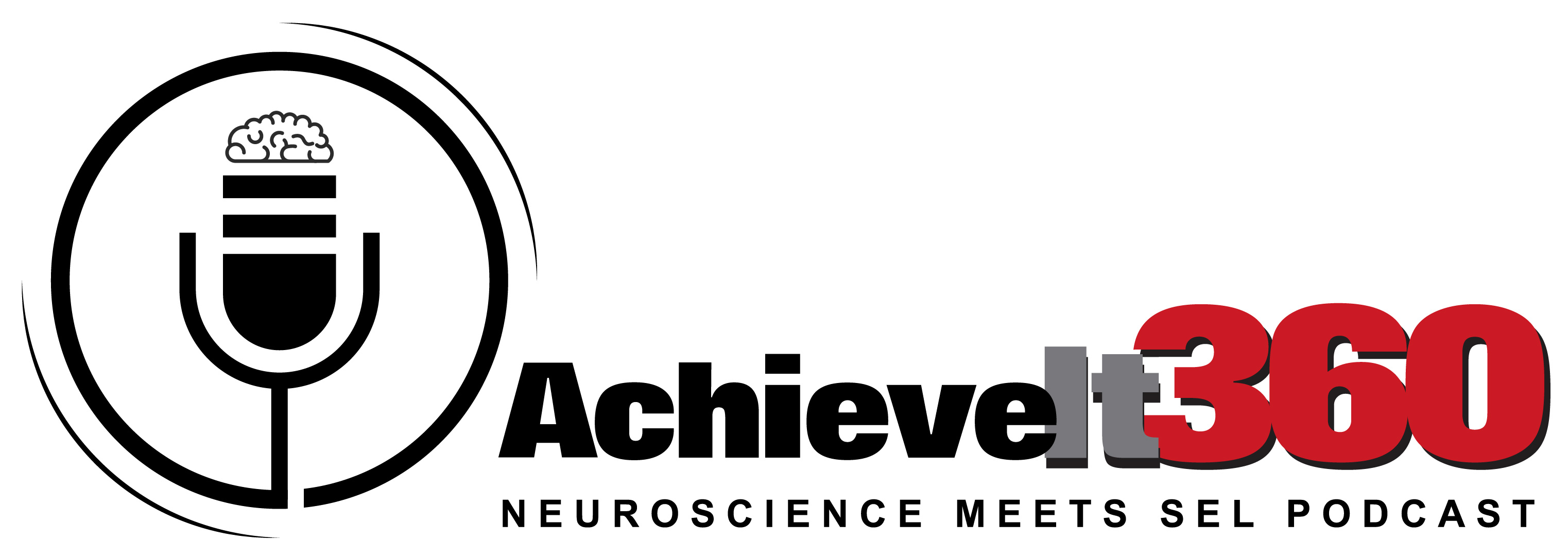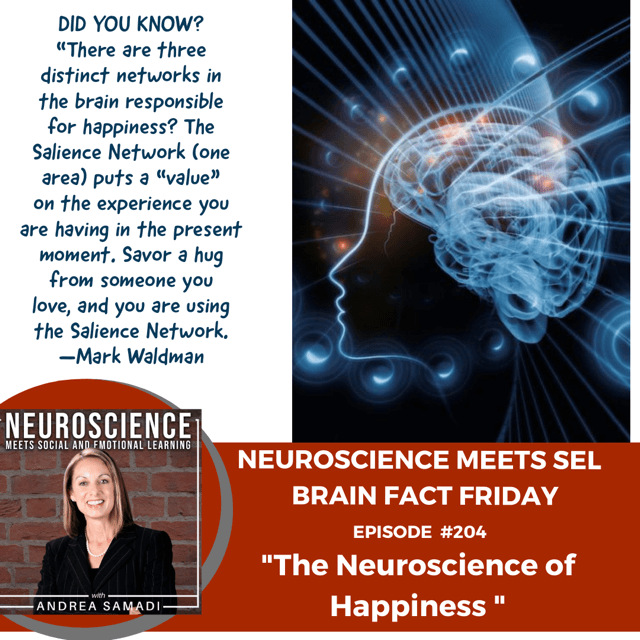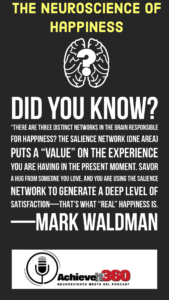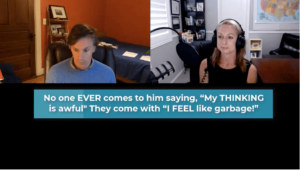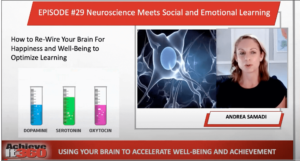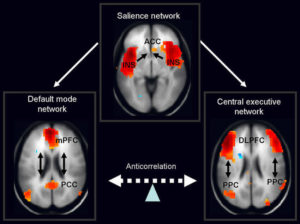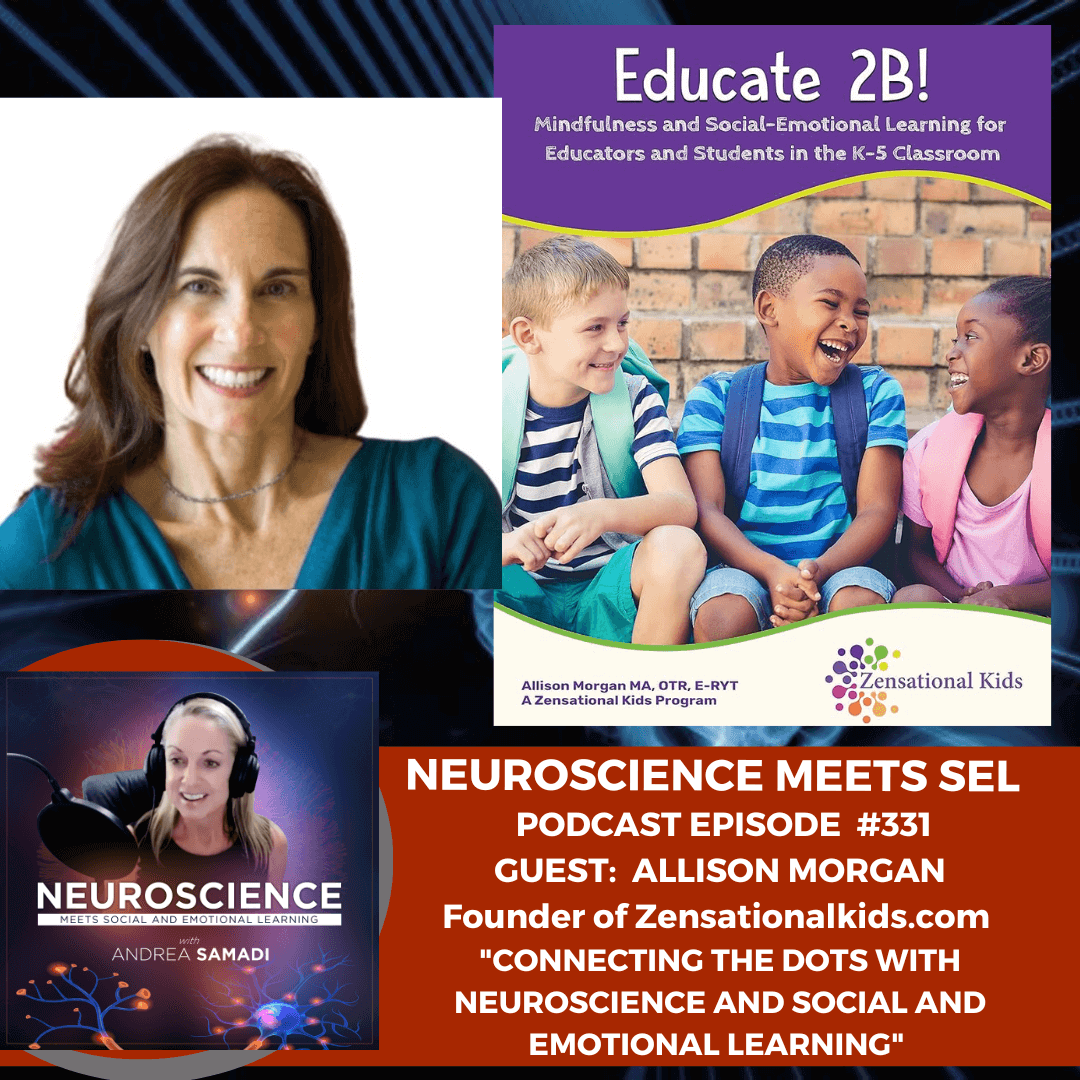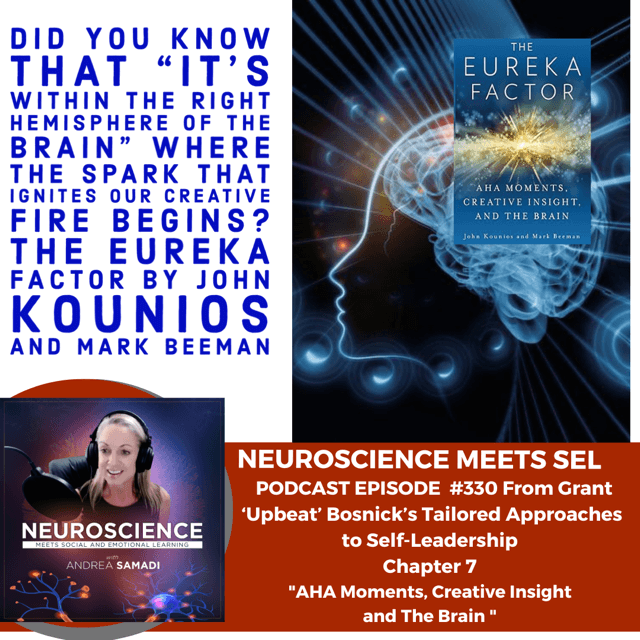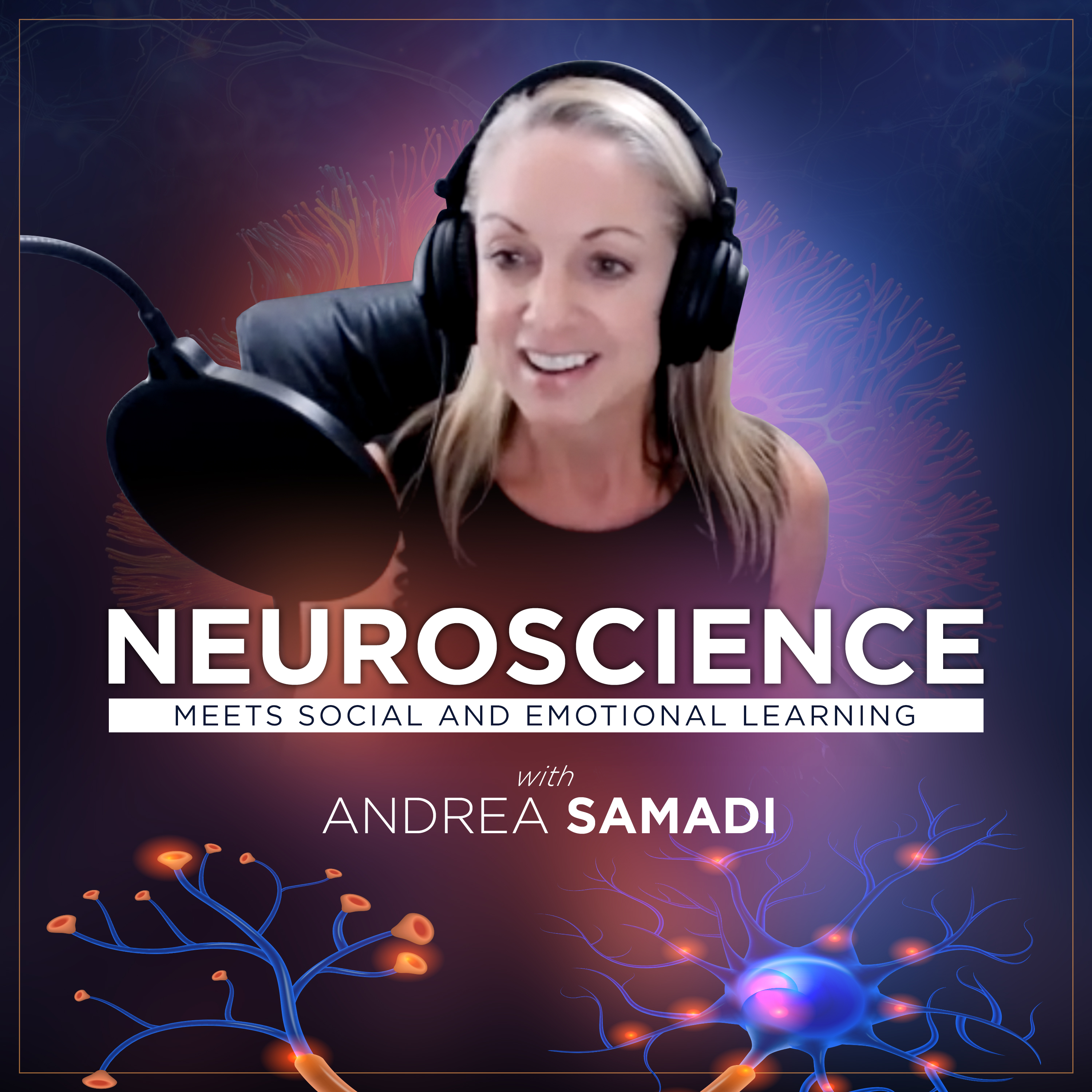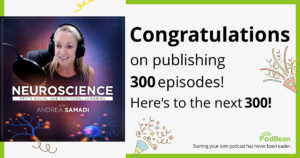Did you know that “from a neuroscientific standpoint, happiness is experienced in different ways depending on your state of mind?” Mark Waldman
For this week’s Brain Fact Friday, and EPISODE #204, with all that is going on in the world, I wanted today’s episode to take a closer look at how we can all find happiness in our life, even during the most difficult times, and look at happiness through a neuroscientific lens. If we can do this, I am confident that we will all walk away from this episode with a way to generate happiness, with our brain in mind.Welcome back! I’m Andrea Samadi, author, and educator from Toronto, Canada, now in Arizona, and we launched this podcast almost 3 years ago, with the goal of taking the mystery out the science behind high performance strategies, so that we can all apply the most current brain research, to improve productivity and results in our schools, sports and modern workplaces. I became interested in success strategies to improve performance in the late 1990s while working with some of world’s top performers in the motivational speaking industry and saw immediately how important these skills were for our future generations.
For those who have been with us since we launched, thank you for coming back, for listening, and supporting the podcast over the years. The topics we cover each week seem to be never-ending, as more research continues to be uncovered, each episode connects back to past episodes that you might remember from our earlier days.
Bringing us to this week’s Brain Fact Friday.
Did you know that “there are three distinct networks in the brain responsible for happiness?
It hit me while recording our Top 10 Episodes of All Time[i] when psychologist Dr. Francis Lee Stephens said “no one ever comes to me saying my thinking is awful. They come with—I feel like garbage.” How do we look for happiness, or positive feelings when we “feel” like garbage?
We covered The Neuroscience of Happiness way back in November 2019 on EPISODE #29[i] and I remember it being such an important topic, that I created a PowerPoint Presentation on YouTube[ii] to go along with this episode where we dove into the recipe for peak performance, with strategies to boost our serotonin levels to generate more happiness. We took a closer look at the neuroscience of anxiety, with ideas to calm our limbic, emotional brain. We were almost a year into the pandemic, and nothing has changed with the importance of mental health and well-being since we recorded EPISODE 29, but today, I want to look at happiness with the latest neuroscience research I’ve recently learned from Mark Waldman, adding a new perspective, hoping that whatever is going on in our lives, wherever you are listening from in the world, that you can look at happiness with this new lens, a neuroscientific lens, and see if the ideas I’ll share can help you today can generate more happiness in your life, as well as mine, as I put these strategies into practice right along with you.
This week I learned that the latest neuroscientific research suggests there are three distinct networks in the brain that generate happiness. As we take a closer look at these three networks, I hope we can think of some NEW strategies to bring real happiness, into our day, with this new knowledge of the specific network of the brain that this feeling is being generated in.
1. Frontal Parietal Network: also called the Central Executive Network (CEN) or our Thinking Network that controls our everyday thoughts and memories about what happiness means to you. Waldman reminds us that these memories are “mostly based on old beliefs and memories of the past and that happiness is something that only occurs briefly in the present moment.” Remember: that your beliefs about happiness are embedded in the past, and that you can think back to old memories that made you happy, but this level of happiness won’t last forever.
HOW DO WE GENERATE MORE HAPPINESS USING THE CEN: Have you ever heard of visualizing yourself in your happy place to shift how you are thinking or feeling? When you actively pull up a memory of yourself, on a beach (let’s say) in the middle of winter, it can help you to feel the sunshine on your face, or smell the salt water for the time you are visualizing, but when you open your eyes, you do come back to reality that you aren’t really on this beach, so this strategy will get you to feel happiness and shift your mood, but there is another strategy that can bring you closer to real happiness.
2. Salience Network: This network (that doesn’t fully develop until we are 28-30 years old) puts a value or level of importance on the experience we are having in the present moment and can “generate a deeper level of satisfaction” which is what real happiness is. When we can savor the experience while it’s happening, like when we savor a hug from someone that you love, you are “using the Salience Network” to generate a deep level of satisfaction. When you can “mindfully immerse yourself in what you are experiencing in the present moment, you can touch those brief moments of pleasure.” (Waldman).
HOW DO WE GENERATE MORE HAPPINESS USING OUR SALIENCE NETWORK: When writing this episode, I asked my youngest daughter to give me one of her “special” hugs because I know that she savors every moment when she hugs someone. In my lifetime, I’ve only ever had a hug like this from one other person, my friend Christian, who we lost in his late 30s, and his hugs were unforgettable. Have you ever felt this? Someone who hugs you and they squeeze you so tightly, they take the air out of you, and they give everything they’ve got with this hug? I remember saying to my friend “ok, enough already” as I could barely breathe with his tight hugs, but now that he’s no longer here, I bet there’s many of us who wish we held on tight for those extra seconds. My daughter’s hugs are like this and she says that she “feels the hug with her heart, closes her eyes and that the squeeze part is important.” She’s definitely mastered the mindful hug that brings happiness to everyone she comes in contact with. I know that during the pandemic, we barely shook hands with each other, let alone give each other those big bear hugs, but if you can hug someone close to you, that you love, and mindfully immerse yourself in this experience, you will feel “real” happiness.
Savor your hugs.
What else can you savor that you really enjoy? If you have ever been really hungry, that first bite of a sandwich tastes extra special. Savor that first bite and you’ll feel what I mean.
I’m sure you can write a list of things that you love that you will take the extra time to savor, to feel this heightened sense of happiness that originates in the Salience Network of your brain.
3. Default Mode Network: or Imagination Network that “generates fantasies about what happiness may or may not be” (Waldman) and this network is active when we are “wishing for happiness” in our life. This “daydream-like realm of imagination can make you desire deeper levels of happiness” but research shows that “seeking happiness in this way increases depression.” (Waldman). We dove deep into the DMN back on EPISODE #48[iii] in March 2020 with ideas for using this new brain science to reduce stress and find balance in the major networks in our brain.
HOW DO WE GENERATE MORE HAPPINESS USING THE DEFAULT MODE (OR IMAGINATION) NETWORK? When using mind-wandering to visualize happiness, to prevent yourself from feeling too far away from your goal, bring yourself back to reality by using mental contrasting. This evidence-based strategy, known as the WOOP strategy[iv] (not to be confused with the wearable device that measures sleep and stress). WOOP stands for “Wish, Outcome, Obstacle and Plan” and can help you to keep from drifting off track into negative thinking that sometimes can occur in the DMN. Stay on course by daydreaming for a bit (maybe about a beach vacation) and then switch to your CEN and think of the outcomes of this beach vacation. How incredible would it be to escape reality and just relax poolside for a while? Now bring yourself back to reality with mental contrasting or thinking of the obstacles that you must overcome for this goal to become a reality. Create a plan, and you can turn your happiness daydream into reality.
To review this week’s Brain Fact Friday, we’ve outlined clearly the three networks in the brain responsible for our happiness, with ideas for generating happiness using each one. We can learn to activate these networks together, for example, by thinking of a specific happy memory with our CEN, and savoring it, with our Salience Network, and then using our DMN to further dream, or imagine our happiness memories, switching back to our CEN to create a plan to bring our happy memory to reality. I know this will increase our happiness in all 3 networks of our brain, and hopefully will leave us with an elevated feeling, bringing us as close as we can get to true happiness.
REMEMBER: To savor those hugs, or whatever it is for you that brings you true happiness.
Wishing you a happy weekend, and hope this episode made you smile.
See you next week.
REFERENCES:
[i]Neuroscience Meets Social and Emotional Learning Podcast EPISODE #29 “How to Rewire Your Brain for Happiness and Well-Being to Optimize Learning” https://andreasamadi.podbean.com/e/how-to-re-wire-your-brain-for-happiness-and-well-being-to-optimize-learning/
[ii] PowerPoint Presentation on YouTube for EPISODE #29 “The Neuroscience of Happiness”
[iii]Neuroscience Meets Social and Emotional Learning Podcast EPISODE #48 on “Brain network Theory: Using Neuroscience to Stay Productive” https://andreasamadi.podbean.com/e/brain-network-theory-using-neuroscience-to-stay-productive-during-times-of-change-and-chaos/
[iv] WOOP Strategy https://www.panoramaed.com/blog/setting-goals-woop
[i] Neuroscience Meets Social and Emotional Learning Podcast EPISODE #201 on the Top 10 All Time Episodes https://andreasamadi.podbean.com/e/the-top-10-all-time-episodes-on-the-neuroscience-meets-social-and-emotional-learning-podcast/
Podcast: Play in new window | Download
Subscribe: Apple Podcasts | RSS
